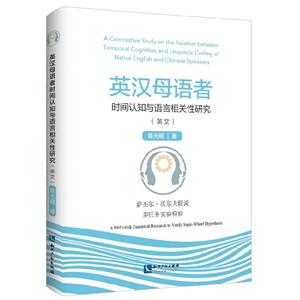扫一扫
关注中图网
官方微博
本类五星书更多>
-
>
西班牙语词根宝典
-
>
英语大书虫世界经典名译典藏书系:中国人的精神 (英汉对照)(精选权威版本)
-
>
许渊冲译唐诗三百首:汉文·英语
-
>
四级词汇词根+联想记忆法:乱序版
-
>
The secret garden
-
>
英国文学名篇选注
-
>
许渊冲译千家诗
买过本商品的人还买了
英汉母语者时间认知与语言相关性研究:萨丕尔.沃尔夫假说多任务实验检验(英文) 版权信息
- ISBN:9787513071154
- 条形码:9787513071154 ; 978-7-5130-7115-4
- 装帧:一般胶版纸
- 册数:暂无
- 重量:暂无
- 所属分类:>>
英汉母语者时间认知与语言相关性研究:萨丕尔.沃尔夫假说多任务实验检验(英文) 内容简介
萨丕尔·沃尔夫假说是一个关于语言、文化和思维之间关系的假说。该假说中所蕴含的理念是对启蒙主义时期“语言—思维”观(思维与语言是两个不同过程,且前者接近制约后者)的反拔。本书采用新沃尔夫主义者的研究范式,以英汉母语者为实验对象,在时间领域对该假说进行了检验。实验结果表明:两组被试的时间认知既有共性,也存在显著差异;已有时间认知模型对英汉母语者时间认知图式的描述存在偏差;人类时间认知的形成基于一个复杂的经验基础网络,作为这个网络的组成部分,语言因素确会影响人脑中时间表征的形成。本书可作为认知语言学实证研究领域的参考用书。
英汉母语者时间认知与语言相关性研究:萨丕尔.沃尔夫假说多任务实验检验(英文) 目录
Contents
Chapter 1.Introduction: what is SWH .........................................................................1
1.1 A brief history of SWH..........................................................................3
1.2 Different terms used to address SWH .................................................13
1.3 Different interpretations of SWH ........................................................19
1.4 Misusage .............................................................................................23
1.5 Key terms in SWH ..............................................................................26
1.6 Summary: What is SWH .....................................................................32
Chapter 2 Literature review of empirical studies on SWH ....................................33
2.1 Literature review on empirical studies in the neo-Whorfian period
(articles presented in English) .............................................................38
2.2 Literature review on empirical studies in the neo-Whorfian period
(articles presented in Chinese) ............................................................98
2.3 Summary ...........................................................................................101
Chapter 3 Research methodology: the neo-Whorfian research paradigm .......103
3.1 Picking a domain: the domain of time .............................................104
3.2 Linguistic coding of time in Chinese and English ............................109
3.3 Non-linguistic coding of time in the cognition of native speakers of
Chinese and English: temporal representations in cognition ............120
3.4 Summary ..........................................................................................136
Chapter 4 Do native Chinese and English speakers think about time
differently because they talk about time differently ..........................137
4.1 Experiment 1: time in spontaneous gestures .....................................139
4.2 Experiment 2: time in deliberate gestures .........................................171
4.3 Experiment 3: the STARC effect .......................................................215
Chapter 5 Conclusion ................................................................................................238
5.1 Answers to the research questions .....................................................238
5.2 Weaknesses of the present research ..................................................243
References .......................................................................................................................245
Appendixes.....................................................................................................................269
Appendix 1: spontaneous gestures of native Chinese speakers
(presented in interview order) ....................................................................270
Appendix 2: spontaneous gestures of native English speakers
(presented in interview order) ....................................................................285
Appendix 3: questions for native Chinese speakers in Experiment 2 ........307
Appendix 4: questions for native English speakers in Experiment 2 .........308
Chapter 1.Introduction: what is SWH .........................................................................1
1.1 A brief history of SWH..........................................................................3
1.2 Different terms used to address SWH .................................................13
1.3 Different interpretations of SWH ........................................................19
1.4 Misusage .............................................................................................23
1.5 Key terms in SWH ..............................................................................26
1.6 Summary: What is SWH .....................................................................32
Chapter 2 Literature review of empirical studies on SWH ....................................33
2.1 Literature review on empirical studies in the neo-Whorfian period
(articles presented in English) .............................................................38
2.2 Literature review on empirical studies in the neo-Whorfian period
(articles presented in Chinese) ............................................................98
2.3 Summary ...........................................................................................101
Chapter 3 Research methodology: the neo-Whorfian research paradigm .......103
3.1 Picking a domain: the domain of time .............................................104
3.2 Linguistic coding of time in Chinese and English ............................109
3.3 Non-linguistic coding of time in the cognition of native speakers of
Chinese and English: temporal representations in cognition ............120
3.4 Summary ..........................................................................................136
Chapter 4 Do native Chinese and English speakers think about time
differently because they talk about time differently ..........................137
4.1 Experiment 1: time in spontaneous gestures .....................................139
4.2 Experiment 2: time in deliberate gestures .........................................171
4.3 Experiment 3: the STARC effect .......................................................215
Chapter 5 Conclusion ................................................................................................238
5.1 Answers to the research questions .....................................................238
5.2 Weaknesses of the present research ..................................................243
References .......................................................................................................................245
Appendixes.....................................................................................................................269
Appendix 1: spontaneous gestures of native Chinese speakers
(presented in interview order) ....................................................................270
Appendix 2: spontaneous gestures of native English speakers
(presented in interview order) ....................................................................285
Appendix 3: questions for native Chinese speakers in Experiment 2 ........307
Appendix 4: questions for native English speakers in Experiment 2 .........308
展开全部
英汉母语者时间认知与语言相关性研究:萨丕尔.沃尔夫假说多任务实验检验(英文) 作者简介
陈光明,女,博士研究生,讲师。北京语言大学英语语言文学博士毕业,现任职北京语言大学外国语学部英语学院,主要从事语言与文化对比研究。主持并完成多个北京语言大学院、校级项目,主持教育部青年项目,在《语言教学与研究》等杂志发表文章。
书友推荐
- >
二体千字文
二体千字文
¥22.4¥40.0 - >
名家带你读鲁迅:朝花夕拾
名家带你读鲁迅:朝花夕拾
¥10.5¥21.0 - >
龙榆生:词曲概论/大家小书
龙榆生:词曲概论/大家小书
¥13.0¥24.0 - >
唐代进士录
唐代进士录
¥25.5¥39.8 - >
姑妈的宝刀
姑妈的宝刀
¥9.0¥30.0 - >
伊索寓言-世界文学名著典藏-全译本
伊索寓言-世界文学名著典藏-全译本
¥9.3¥19.0 - >
随园食单
随园食单
¥15.4¥48.0 - >
大红狗在马戏团-大红狗克里弗-助人
大红狗在马戏团-大红狗克里弗-助人
¥3.5¥10.0
本类畅销
-
赖世雄的英语学习法
¥16.4¥45 -
4.23文创礼盒A款--“作家言我精神状态”
¥42.3¥206 -
4.23文创礼盒B款--“作家言我精神状态”
¥42.3¥206 -
一句顶一万句 (印签版)
¥40.4¥68 -
百年书评史散论
¥14.9¥38






















